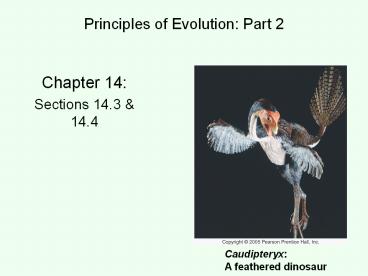Principles%20of%20Evolution:%20Part%202 PowerPoint PPT Presentation
Title: Principles%20of%20Evolution:%20Part%202
1
Principles of Evolution Part 2
Chapter 14 Sections 14.3 14.4
- Caudipteryx
- A feathered dinosaur
2
Evidence that evolution has occurred
- Progressive series of fossils
- Ancient form ? Intermediate stages (several) ?
modern form - Example Evolution of the horse Fig. 14.6
- What types of changes occurred in teeth, hooves
and body size and how are these changes adaptive? - NOTE Many of these types of series exist for a
variety of organisms.
3
(No Transcript)
4
Evidence that evolution has occurred
- Homologous structures structures that may
differ in function but have common anatomy,
suggesting that they were derived from a common
ancestor. - Example forelimbs of birds and mammals
- Can clearly identify similar arrangement of bones
- Modifications of these bones are related to their
functions
5
(No Transcript)
6
Evidence that evolution has occurred
- Vestigial structures structures that serve no
apparent purpose, but are homologous with
functional structures in related organisms - Often reduced in size
- Examples
- Pelvic/hindlimb bones of some snakes and whales
indicate relationship with animals that use their
hindlimbs. - Molars in blood-sucking vampire bats indicate
relationship with bats that chew food.
7
(No Transcript)
8
Evidence that evolution has occurred
- Convergent evolution Similar characteristics in
organisms arise due to similarity in environment
or lifestyle, rather than relatedness - Similar characteristics that arise via convergent
evolution are analogous - KEY Structures of two organisms are considered
analogous if they share no common ancestor with
the particular structure!
9
Examples of analogous structures that arose via
convergent evolution
- Insects and birds have no common ancestor with
wings! - Thus, their wings are analogous structures!
10
Homologous vs. analogous characteristics
- Describe a characteristic shared by seals and
birds that is homologous between these animals. - Hint Birds and mammals probably share a ancient
reptilian ancestor.
- Describe a characteristic shared by seals and
penguins that is analogous between these animals.
- Hint seals evolved from dog-like animals
penguins from flying birds.
11
Evidence that evolution has occurred
- Embryological similarities
- These are early embryos of a) a lemur, b) a pig,
and c) a human.
12
Evidence that evolution has occurred
- Biochemical and genetic similarities among all
organisms suggest common ancestry of all life. - All cells use DNA as the molecule of heredity.
- All cells use the same 20 amino acids to build
proteins. - Many other examples!
13
Evidence that evolution occurs by natural
selection
- Artificial selection works.
- Humans breed plants and animals for desired
traits. - Organisms with desired traits are allowed to
breed their traits persist while less desired
traits dont. - Humans, rather than some other aspect of nature
are the selective force.
14
Evidence that evolution occurs by natural
selection
- Many current examples of natural selection.
- Example Evolution of cockroaches to ignore
Combat, a poison bait - Most roaches were attracted to Combat and killed
- A very small percentage of roaches did not like
the bait (disliked glucose) due to a rare
mutation. - These roaches survived and reproduced, and thus
increased in the population! - Over time, these Combat-resistant roaches
dominated, and Combat was no longer effective. - Note See also the guppy and lizard examples!

